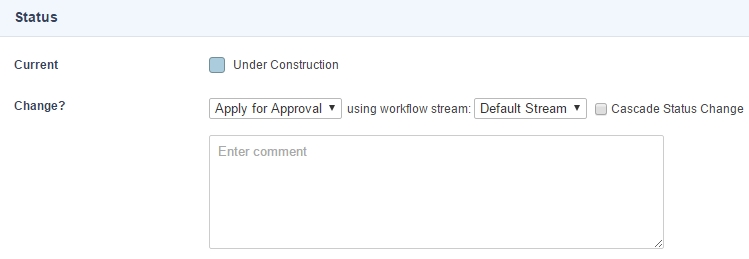Workflow approval concepts
If you are new to workflows in Matrix, start here to learn some of the basic concepts and rules.
The approval process
When an asset has workflow applied, a user will not be able to edit the asset if its status is live. To edit an asset, the user needs to change the status to Safe edit.
Once they have finished editing an asset, they can start the approval process by selecting Apply for approval in the status field on the Details screen of the asset.
The user also needs to Apply for approval when the status of the asset is Under construction, and they want to make it live.
Applying for approval
If a user has admin permission on the asset, the Using workflow stream field will be displayed in the status section of the Details screen of the asset, as shown:

This field will become available when the status change field begins the workflow approval process. For example, Apply for approval or Place up for review. In this field, select either the Default stream or any available Alternate streams to use for the approval process.
When a user applies for approval, the users involved in the first step of the process will receive an email:

They need to review the changes to the asset and either approve or reject them.
Approving and rejecting
To approve or reject the changes, go to the Workflow screen of the asset. In the Change status field, select either Approve changes or Reject changes. You can enter a reason for your decision into the Log message box. Once you have done this, click Save.
If you reject the workflow approval, the asset will revert to its previous status. For example, if the asset status was Safe edit, rejecting it during workflow will revert it to Safe edit. The changes made to the asset will not be lost.
When step one has been approved and completed, step two will commence. The users that are part of step two will receive an email. They need to view the changes and either approve or reject them on the asset’s Workflow screen.
This process continues until all steps have been approved. Once all steps are complete, the status of the asset changes to either Approved or Safe edit approved. An administrator can then change the status of the asset to Live.
Administrator privileges
An administrator, system administrator, or the root user can reject the approval process at any point. To do this, go to the Workflow screen of the asset. In the Change status field, select Reject changes and click Save.
However, the inverse is not true: the administrator, system administrator, or root user cannot approve the changes unless they are part of a condition in the Workflow stream.
Automatic approval
If the person applying for approval is part of a condition in the first step, this step will be automatically approved. The second step will commence.
Take, for example, an asset with the condition that user John Smith must approve it. If John Smith applies for approval on that asset, the step will be automatically approved, and the second step will commence.
Similarly, if there is only one step in the workflow stream, no user that is part of a condition in that stream will undertake the approval process.
For example, any changes made by the example user John Smith, will not go through the approval process. If, however, another user changes the asset, John Smith will have to approve those changes.
Automatic approval of multiple steps
Matrix will automatically approve as many steps as possible in the process until it encounters a step that requires further approval.
For example, assume John Smith is part of the Content approvers user group. You set up a workflow stream that requires John Smith to approve the first step, and the Content approvers user group to approve the second. When John Smith approves step one, step two will also be approved, as he is part of the required user group.
Temporary Approval Permissions
If a user in an approval step does not have the appropriate permissions for an asset, workflow will grant them temporarily when it reaches that step.
The type of temporary permission is dependent on what type of user they are, as defined in the table below:
| User type | Read permission | Write permission | Can approve or reject |
|---|---|---|---|
User |
Yes |
No |
Yes |
Simple Edit user |
Yes |
No |
Yes |
Backend user |
Yes |
Yes |
Yes |